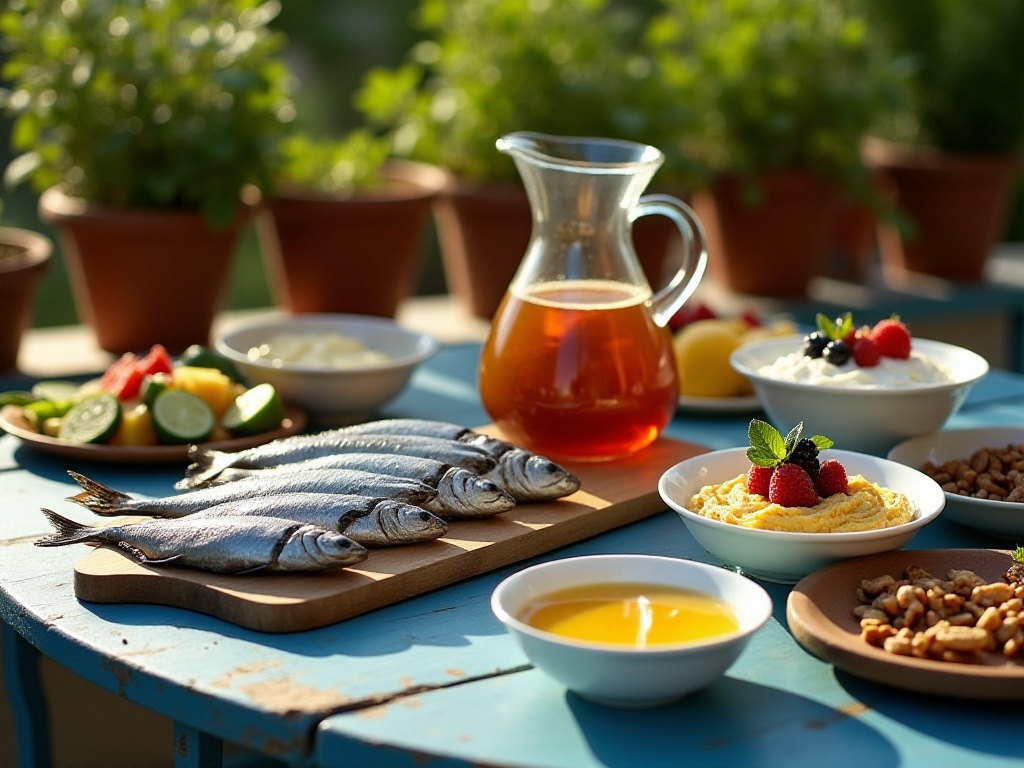Introduction
As someone born after 1995, I deeply feel that advertisements for various nutritional supplements are absolutely everywhere these days. "Health experts" on social media constantly shout "you're deficient in this" and "you're deficient in that," making us young people extremely anxious. However, after years of in-depth research and practice, I've discovered that nutritional supplementation isn't actually that complicated - the key is returning to basics, starting with fundamental diet.
Young people today are particularly susceptible to being influenced by nutrition product advertisements, often feeling they need to supplement with various nutrients. The other day, my friend spent over a thousand yuan just on supplements in one month, yet couldn't even maintain proper regular meals. Isn't this putting the cart before the horse? In fact, if we grasp correct dietary concepts, we can obtain all the nutrition our bodies need through daily diet, and it's particularly economical too.
Fiber is King
To be honest, when I first started studying nutrition, I also fell into the protein and vitamin trap. It wasn't until I read extensive research literature that I discovered dietary fiber is the true king of nutrition. The latest research data shows that consuming 25-30 grams of dietary fiber daily not only significantly reduces cardiovascular disease risk but also prevents colorectal cancer. Moreover, adequate fiber intake helps maintain a slim figure - after all, in today's appearance-focused society, who doesn't want to maintain a good figure?
Many people might think reaching daily fiber intake of 25-30 grams is difficult, but it can be easily achieved with slight dietary changes. For example, we can switch from white rice to brown rice. The texture of brown rice might take some getting used to initially, but after persisting for a while, you'll find it's not only chewy but particularly filling. Plus, brown rice's fiber content is several times that of white rice.
The same principle applies to bread. Rather than buying refined white bread, choose whole wheat bread. Many young people like eating bread for breakfast now - if switched to whole wheat bread, one breakfast can easily provide 4-5 grams of fiber. Add an apple, and the fiber intake becomes even more substantial.
Speaking of fruits, many people might think they're mainly for vitamin supplementation, but fruits are also an important source of dietary fiber. For example, a medium-sized apple contains about 4 grams of fiber. Moreover, apple fiber is primarily soluble fiber, which is particularly beneficial for gut health. Now that gut care is trending, rather than spending big money on probiotics, why not eat more fiber-rich fruits?
Vegetables are even more of a treasure trove of dietary fiber. Take broccoli for example - one serving of cooked broccoli (about 100g) contains 3 grams of fiber. Plus, broccoli is particularly nutritious, rich in vitamin C, folate, potassium, and other nutrients. I personally love cutting broccoli into small florets, blanching them briefly, then drizzling with olive oil and salt - simple and delicious.
Oatmeal is another of my favorites. Many young people now like having instant coffee with bread for breakfast, but switching to a bowl of oatmeal would be more nutritious. One bowl of oatmeal (about 40g) contains 4 grams of fiber, plus rich B vitamins and minerals. I usually add some nuts and fruits to my oatmeal, which not only improves taste but also increases nutritional value.
The Truth About Fats

Good Fats vs Bad Fats
When it comes to fat, many people, especially women, get scared just hearing the word. But everyone should know that fat is one of the essential nutrients for the human body. According to nutritional guidelines, adults need to consume 60-80 grams of fat daily - the key is distinguishing which are beneficial "good fats."
Omega-3 fatty acids in deep-sea fish are typical "good fats." For example, a cooked salmon fillet (about 150g) contains 2.3 grams of omega-3 fatty acids. Many young people think salmon is too expensive, but you can choose more budget-friendly sardines. A can of sardines is not only affordable but particularly nutritious, and very convenient - just open the can and eat.
Speaking of economical good fat sources, walnuts are definitely one of the top choices. Eating a handful of walnuts (about 30g) daily provides 18 grams of quality fatty acids. Plus, walnuts are rich in vitamin E and minerals, particularly beneficial for brain health. Many young people now face high work pressure and often need to work overtime - why not keep some walnuts in the office to eat when hungry, providing both energy and nutrition.

Smart Oil Consumption
Regarding cooking oil selection, many people might think olive oil is the best choice. But actually, different cooking methods are suited for different cooking oils. My suggestion is to choose suitable oils based on cooking method and budget.
For daily stir-frying, I most recommend tea seed oil. Tea seed oil has a relatively high smoke point and is relatively affordable, particularly suitable for stir-frying. Plus, tea seed oil contains rich monounsaturated fatty acids, beneficial for cardiovascular health.
For cold dishes, I choose flaxseed oil. Flaxseed oil is rich in omega-3 fatty acids but doesn't tolerate high temperatures, so it's most suitable for cold dishes. Plus, flaxseed oil has a special nutty aroma that particularly enhances the flavor of cold vegetables.
As for frying, I personally recommend peanut oil. Peanut oil is affordable and tolerates high temperatures, particularly suitable for frying. However, regardless of which oil is used for frying, the intake of fried foods should be controlled.
Nutritional Pairing
Smart Combinations
When it comes to nutritional pairing, there's much to learn. Many nutrients have relationships of mutual promotion or inhibition - understanding these relationships is particularly important for improving nutrient absorption and utilization rates.
For example, iron absorption needs vitamin C's help. So when we eat iron-rich foods, it's best to pair them with vitamin C-rich foods. In practice, when we eat spinach, we can pair it with an orange or lemon. This not only increases vitamin C intake but also improves iron absorption rate.
The relationship between calcium and vitamin D is similar. Vitamin D promotes calcium absorption, so when supplementing calcium, it's best to pay attention to vitamin D supplementation simultaneously. For example, when drinking milk, if you can get some sun exposure, calcium absorption will be better. However, many young people now work long hours, making it difficult to get sun exposure. In this case, we can choose to go out more and get some sun on weekends.

Money-Saving Methods
Many people think healthy eating is expensive, but this is a misconception. With the right methods, we can buy highly nutritious foods at very economical prices.
For example, for iron supplementation, many people's first reaction is to buy iron supplements. Actually, pork liver is an excellent iron-rich food ingredient, and it's particularly affordable. A pound of pork liver only costs ten-plus yuan, but its iron content equals several hundred yuan worth of iron supplements. Plus, pork liver is rich in vitamin A and B vitamins, with particularly high nutritional value.
Another example is iodine supplementation - many people might think of eating kelp. But buying fresh kelp might not be convenient; you can buy some dried kelp instead. Dried kelp keeps particularly well, and a small amount bought at once can last a long time. Five yuan worth of dried kelp, when rehydrated, contains enough iodine for a week's consumption.
Practical Tips

Meal Prep Rules
When it comes to healthy eating, many people find it particularly troublesome. Actually, with some simple techniques, healthy eating can become very easy. For example, my most frequently used "rainbow plate method" ensures at least three different colored ingredients on each meal plate.
This method looks simple but works particularly well. Because different colored ingredients usually contain different nutrients, this method ensures we intake more balanced nutrition. For example, red tomatoes contain rich lycopene, green broccoli is rich in folate and vitamin C, and yellow corn contains rich carotenoids.
To make regular meal prep more convenient, I usually do some ingredient preparation work on weekends. For example, washing and cutting durable vegetables like carrots and broccoli, and storing them in food containers. This way, when I want to eat them, I can just take them out and use them - particularly convenient.
I also prepare some ready-to-eat healthy snacks, like boiled eggs, nuts, fruits, etc. This way, when hungry during busy work times, I can supplement some healthy nutrition anytime. Many young people now like ordering takeout, but if you can prepare some ingredients in advance, cooking yourself isn't very troublesome.

Shopping Tips
Regarding shopping, I have a particularly practical "outer circle rule." When shopping in supermarkets, mainly browse the outer circle. Because supermarket outer circles usually display fresh vegetables, fruits, meats, and other ingredients, while the middle area mostly has processed foods.
This method is particularly suitable for young people today. Because we face high work pressure daily, we're easily tempted by various snacks. If we mainly shop in the supermarket's outer circle, we can avoid buying too many processed foods. Plus, fresh ingredients not only have higher nutritional value but are usually more affordable than processed foods.
Additionally, I particularly recommend developing the habit of reading food ingredient labels. Ingredients on the label are listed in descending order by weight, meaning ingredients listed first have higher content. By reading ingredient labels, we can avoid foods with excessive additives.
For example, when buying juice, if sugar is listed first in the ingredients, it indicates the juice has high sugar content. Another example is when buying cookies - if the ingredient list has many incomprehensible chemical names, it might mean there are many additives.
Concluding Thoughts
Through years of practice and research, I increasingly feel that nutritional supplementation is actually a very simple thing. The key isn't how many supplements to buy, but how to make our daily diet more reasonable.
Young people today face great life pressure, but health is really important. Rather than spending money on various nutritional supplements, it's better to properly plan your daily diet. Starting with changing your plate, gradually cultivating healthy eating habits - this is the most economical and sustainable way of nutritional supplementation.
Remember, healthy eating isn't bought with money, but planned out. Let's start together by changing our plates to create a healthier lifestyle. After all, we young people should take responsibility for our own bodies and lay a healthy foundation for our future lives.







